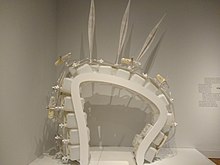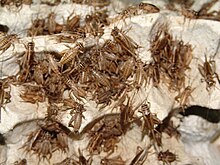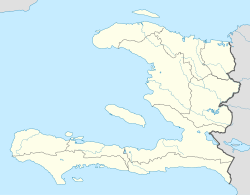Insects as food
Insects as food or edible insects are insect species used for human consumption, e.g., whole or as an ingredient in processed food products such as burger patties, pasta, or snacks.
Edible insects
Frequently consumed insect species
Estimates of numbers of edible insect species consumed globally range from 1,000 to 2,000.[1] These species include 235 butterflies and moths, 344 beetles, 313 ants, bees and wasps, 239 grasshoppers, crickets and cockroaches, 39 termites, and 20 dragonflies, as well as cicadas.[2] Which species are consumed varies by region due to differences in environment, ecosystems, and climate.
The table below lists the top five insect orders consumed by humans worldwide, retrieved from Edible Insects: Future Prospects for Food and Feed Security by Arnold van Huis, Joost Van Itterbeeck, Harmke Klunder, Esther Mertens, Afton Halloran, Giulia Muir and Paul Vantomme.[3]
| Order of insect | Common name | Consumption rate worldwide by human population (%) |
|---|---|---|
| Coleoptera | Beetles | 31 |
| Lepidoptera | Butterflies, moths | 18 |
| Hymenoptera | Bees, wasps, ants | 14 |
| Orthoptera | Grasshoppers, locusts, crickets | 13 |
| Hemiptera | Cicadas, leafhoppers, planthoppers | 10 |
For a list of edible insects consumed locally see: List of edible insects by country.
Edible insects for industrialized mass production
To increase consumer interest in Western markets such as Europe and North America, insects have been processed into a non‐recognizable form, such as powders or flour.[4] Policymakers, academics,[5] as well as large-scale insect food producers such as Entomofarms in Canada, Aspire Food Group in the United States,[6] Protifarm and Protix in the Netherlands, and Bühler Group in Switzerland, focus on seven insects species suitable for human consumption as well as industrialized mass production:[7]
- Mealworms (Tenebrio molitor) as larvae
- Lesser mealworms (Alphitobius diaperinus) as larvae, mostly marketed under the term buffalo worms.
- House cricket (Acheta domesticus)
- Tropical house cricket (Gryllodes sigillatus)
- European migratory locust (Locusta migratoria)
- Black soldier fly (Hermetia illucens)
- Housefly (Musca domestica)
Nutritional profile

Insects are nutrient-efficient compared to other meat sources. Insects such as crickets are a complete protein and contain a useful amount of protein, comparable with that from soybeans, though less than in casein (found in foods such as cheese).[8] They have dietary fiber and include mostly unsaturated fat and contain some vitamins, such as vitamin B12,[9] riboflavin and vitamin A, and essential minerals.[10][11]
Locusts contain between 8 and 20 milligrams of iron for every 100 grams of raw locust, whereas Beef contains roughly 6 milligrams of iron in the same amount of meat. Crickets are also very efficient in terms of nutrients. For every 100 grams of substance crickets contain 12.9 grams of protein, 121 calories, and 5.5 grams of fat. Beef contains more protein containing 23.5 grams in 100 grams of substance, but also has roughly triple the calories and four times the amount of fat as crickets do in 100 grams.
| Nutritional value per 100 g | Mealworms (Tenebrio molitor) | Buffalo worms (Alphitobius diaperinus) | House crickets (Acheta domesticus) | Migratory locust (Locusta migratoria) |
|---|---|---|---|---|
| Energy | 550 kcal / 2303 KJ | 484 kcal/ 2027 KJ | 458 kcal/ 1918 KJ | 559 kcal/ 2341 KJ |
| Fat Of which saturated fatty acids | 37,2 g 9 g | 24,7 g 8 g | 18,5 g 7 g | 38,1 g 13,1 g |
| Carbohydrates Of which sugars | 5,4 g 0 g | 6,7 g 0 g | 0 g 0 g | 1,1 g 0 g |
| Protein | 45,1 g | 56,2 g | 69,1 g | 48,2 g |
| Salt | 0,37 g | 0,38 g | 1,03 g | 0,43 g |
Farming, production, and processing


식용곤충은 전문 곤충농장에서 가축으로 사육된다. 네덜란드나 벨기에 등 유럽 국가뿐 아니라 북미에서도 엄격한 식품법과 인간의 소비에 대한 위생 기준에 따라 곤충이 생산된다.
곤충 종류에 따라 온도, 습도, 사료, 상수원, 주택 등 몇 가지 변수가 적용된다. 곤충은 알에서 애벌레 상태(식충, 적게 먹는 벌레) 또는 성숙한 형태(요충, 메뚜기)로 키워낸 뒤 온도를 낮춰 산업화된 곤충 농장에서 죽인다.[12][13] 그 후에 곤충들은 냉동 건조되어 통째로 포장되거나 벌레 가루로 분쇄되어 제과점 제품이나 과자와 같은 다른 식품에서 가공된다.
영양 성분과 소화가능성 외에도 생산자가 쉽게 양육할 수 있도록 곤충을 선정하기도 한다. 여기에는 질병에 대한 민감성, 사료 전환의 효율성, 발달률 및 세대교체가 포함된다.[14]
곤충식품
북미, 캐나다 및 EU의 여러 생산자가 다음과 같은 가공 식품을 생산한다.
- 곤충 밀가루: 분쇄, 냉동 건조 곤충(예: 크리켓 밀가루)
- 곤충 버거: 곤충 분말/곤충 분말(주로 식충이나 집 크리켓에서 만든)과 추가 재료로 만든 햄버거 패티.[15]
- 곤충 피트니스 바: 곤충 가루를 함유한 단백질 바(대부분 집귀뚜라미)
- 곤충 파스타: 밀가루로 만든 파스타로, 곤충 밀가루(집귀뚜라미 또는 식충)로 강화된다.
- 곤충 빵(핀란드 식칼리페): 곤충 밀가루로 구운 빵(대부분 집귀뚜라미)[16]
- 곤충 간식: 곤충 분말 및 기타 재료로 만든 크리스프, 플립 또는 작은 간식(비트)[17]
호주의 양조장 벤츠포크 양조업체와 남아프리카 스타트업 고메 그루브 등 식품·음료업체들은 곤충 아이스크림은 물론 우유 대체품인 곤충 [18]기반 맥주까지 선보였다.[19]
식품안전
규정 및 승인
EU
EU에서 식용 곤충(예: 다리, 날개 또는 머리)은 유럽위원회가 제공하는 새로운 식품의 정의에 해당된다.[20] 몇몇 곤충 종에 대한 서류는 현재 유럽 식품안전청(European Food Safety Authority)에 의해 검토되고 있다. 2018년 8월, EFSA는 집 크리켓에 대한 첫 번째 위험 프로필을 음식으로 발표했다.[21] EFSA가 2021년 1월 13일 발표한 위험도 평가에 따르면 황충은 사람이 먹어도 안전하다.[22][23] 2021년 7월 2일, EFSA는 냉동, 건조 또는 접지된 상태의 철새 메뚜기가 인간의 소비에 안전하다는 또 다른 과학적 의견을 발표했다.[24] EFSA는 2021년 8월 17일 집귀뚜라미(아체타 국내산)[25]를 대상으로 집귀뚜라미 전원의 냉동 건조 제형이 소비하기에 안전하다는 안전평가를 발표했다.
유럽위원회는 EU에서 다음과 같은 식용 곤충을 새로운 식품으로 승인했다.
- 2021년 6월 1일 위원회 시행규칙(EU) 2021/882와 함께 건조된 테네브리오 어금니 애벌레(식충)는 2021년 6월 22일 공포된 지 20일 만에 시행됐다.[26]
- 2021년 11월 12일 위원회 시행 규정(EU) 2021/1975와 함께 냉동, 건조, 분말 형태의 철새 메뚜기(Locusta Migratoria)[27] 이 규정은 2021년 12월 5일 공포된 지 20일 만에 시행됐다.
스위스
스위스는 2017년 5월 1일 다음과 같은 곤충류를 식품으로 승인했다.[28]
특정한 조건 하에서 이것들은 전체 동물로서 소비자에게 제공되거나 분쇄되거나 식품에서 가공될 수 있다.
영국
브렉시트 전환기 이후 2021년 1월 21일 영국에서는 식용곤충에 대한 규제가 바뀌면서 허가 없이는 시장성이 없다. 시중에 나와 있던 곤충식품은 회수해야 했다. 곤충식품은 새로운 식품허가 과정에서 식품표준원의 허가를 받아야 한다.[29][30]
미국과 캐나다
미국과 캐나다에서는 인간의 소비를 위한 곤충은 새로운 식품으로 분류되지 않고 수입과 판매가 허용된다. 미국에서 곤충 식품은 FDA 표준 및 식품 라벨 표시 규정(알레르기 위험 라벨 표시 포함)을 준수해야 한다.
당면 과제 및 안전 문제
생산과 안전에 대한 우려로 인해 발생할 수 있는 몇 가지 도전들이 있다.
곤충산업의 대량생산은 곤충을 효율적으로 수확해 생산할 수 있는 기술과 자금 부족으로 고민거리다. 그 기계는 곤충의 발달에 핵심인 온도 조절뿐만 아니라 곤충의 수명 주기마다 적절한 울타리를 쳐야 할 것이다.[32]
업계는 또한 곤충의 유통기한을 동물 제품에 비해 고려해야 하는데, 이는 식품 안전에 대한 우려가 있기 때문이다. 곤충은 오염물질, 병원균, 중금속 농도, 알레르겐, 살충제 등과 같은 잠재적 위험을 축적할 수 있는 능력을 가지고 있다.[33]
아래 표는 식품과학 및 식품안전 종합검토에 발표된 두 연구 자료를[34][35] 종합하여 인간이 소비하는 5대 곤충종의 잠재적 위해성을 요약하였다.
| 곤충순서 | 공용명 | 위험 범주 | 잠재적 위험 |
|---|---|---|---|
| 콜롭테라속 | 딱정벌레 | 케미컬 | 호르몬 |
| 시아노겐트 물질 | |||
| 중금속오염 | |||
| 레피도프테라속 | 누에 | 알레르기 있는 | |
| 케미컬 | 티아미나제 | ||
| 벌집나방 | 미생물 | 높은 세균수 | |
| 케미컬 | 시아노겐트 물질 | ||
| 히메놉테라속 | 개미 | 케미컬 | 반감소인자(타닌, 피타테) |
| 오르토프테라속 | 하우스 크리켓 | 미생물 | 높은 세균수 |
| 헤미프테라속 | 파라시컬 | 차가스병 | |
| 디프테라 | 흑사병 플라이 | 파라시컬 | 마이아시스 |
위와 같은 곤충의 위험은 다양한 방법으로 조절할 수 있다. 알레르기에 취약한 소비자의 소비를 피하기 위해 포장에 알레르기 위험을 라벨로 표시할 수 있다. 선택적 농업은 화학적 위험을 최소화하는 데 이용될 수 있는 반면, 미생물과 기생적 위험은 조리 과정에 의해 통제될 수 있다.[36]
인식
10월 23일 열리는 세계 식용곤충의 날은 벨기에 기업가인 크리스 데루더가 유럽, 북미, 호주를 중심으로 식용곤충 소비에 대한 세계적인 인식을 높이기 위해 2015년 도입했다.[37]
참고 항목
각주
- ^ Ramos-Elorduy, Julieta (2009). "Anthropo-Entomophagy: Cultures, Evolution And Sustainability". Entomological Research. 39 (5): 271–288. doi:10.1111/j.1748-5967.2009.00238.x. S2CID 84739253.
- ^ Ramos-Elorduy, Julieta; Menzel, Peter (1998). Creepy crawly cuisine: the gourmet guide to edible insects. Inner Traditions / Bear & Company. p. 150. ISBN 978-0-89281-747-4. Retrieved 2 April 2010.
- ^ van Huis, Arnold. Edible Insects: Future Prospects for Food and Feed Security. Rome. ISBN 9789251075968. OCLC 868923724.
- ^ Melgar‐Lalanne, Guiomar; Hernández‐Álvarez, Alan-Javier; Salinas‐Castro, Alejandro (2019). "Edible Insects Processing: Traditional and Innovative Technologies". Comprehensive Reviews in Food Science and Food Safety. 18 (4): 1166–1191. doi:10.1111/1541-4337.12463. ISSN 1541-4337. PMID 33336989.
- ^ 크리스토스 1세 럼보스, 크리스토스 G 아타나시우(2021년 4월 3일) : '식용으로 곤충: 그들을 이길 수 없다면, 그들을 먹어라!'—7세 이상의 장엄한 세계로. 인: 곤충 과학 저널 21권 2021년 3월 2일 9월 https://doi.org/10.1093/jisesa/ieab019
- ^ Carson, Erin (12 October 2017). "You're going to be eating crickets, so just get over it". Cnet. Archived from the original on 10 October 2018.
- ^ van, Huis, Arnold (2017-09-15). Insects As Food and Feed: From Production to Consumption. ISBN 9789086862962.
- ^ Van Huis, Arnold (2015). "Edible insects contributing to food security?". Agriculture & Food Security. 4 (20). doi:10.1186/s40066-015-0041-5.
- ^ Schmidt, Anatol; Call, Lisa; Macheiner, Lukas; Mayer, Helmut K. (2018). "Determination of vitamin B12 in four edible insect species by immunoaffinity and ultra-high performance liquid chromatography". Food Chemistry. 281: 124–129. doi:10.1016/j.foodchem.2018.12.039. PMID 30658738.
- ^ https://www.huffingtonpost.com/2014/02/10/eating-bugs-food_n_4726371.html?slideshow=true 벌레를 먹기 시작해야 하는 이유
- ^ FAO: 식용곤충: 식량과 식량 안보에 대한 미래의 전망. 온라인: PDF.
- ^ 대서양(2015-09-24) : "인간의 소비를 위해 귀뚜라미를 사육하는 회사들"
- ^ Forbes(2018-01-39) : "차세대 대형 식품 공급원 육성: 귀뚜라미."
- ^ Oonincx, Dennis G. A. B; Van Broekhoven, Sarah; Van Huis, Arnold; Van Loon, Joop J. A (2015). "Feed Conversion, Survival and Development, and Composition of Four Insect Species on Diets Composed of Food By-Products". PLOS ONE. 10 (12): e0144601. Bibcode:2015PLoSO..1044601O. doi:10.1371/journal.pone.0144601. PMC 4689427. PMID 26699129.
- ^ Food Navigator(2018-10-12): 독일 스타트업 버그파운더레이션의 곤충 버거에 관한 기사.
- ^ 로이터(2017-11-23): 핀란드 제빵사는 으깬 귀뚜라미로 만든 빵을 출시한다.
- ^ 버그 버거(2019-3-11): 미래의 음식: 핀란드 버그비트와 노르웨이 식충 빵.
- ^ Hardy, Karen (22 November 2019). "Hop into a BentSpoke beer made of crickets and flies". Canberra Times. Retrieved 5 April 2020.
- ^ Bailey, Stephanie (25 July 2019). "Could this insect ice cream convince you to eat bugs?". CNN. Retrieved 2020-03-01.
- ^ 유럽 위원회(2018-01-03): 질문과 답변: 새로운 식품 규정
- ^ 유럽 식품안전청(2018년 8월 28일): 새로운 음식: 집 크리켓의 위험 프로필.
- ^ 유럽 식품안전청(2021년 1월 13일): 규정(EU) 2015/2283에 따른 새로운 식품으로 건조된 황색 식충(테네브리오 어금니 유충)의 안전. 인: EFSA 저널.
- ^ Boffey, Daniel (2021-01-13). "Yellow mealworm safe for humans to eat, says EU food safety agency". The Guardian. Retrieved 2021-01-15.
- ^ EFSA(2021년 7월 2일): 규정(EU) 2015/2283에 따른 새로운 식품으로 철새 메뚜기(Locusta Migratoria)로부터 냉동 및 건조된 제형의 안전성. 인: EFSA 저널. 제19권 제7호 도이: https://doi.org/10.2903/j.efsa.2021.6667
- ^ EFSA(2021년 8월 17일): 규정(EU) 2015/2283에 따른 새로운 식품으로 온 집귀뚜라미(아체타 국내산)에서 냉동 및 건조된 제형의 안전성. 인: EFSA 저널 2021;19(8):6779.
- ^ EU Commission (2 June 2021): Commission Implementing Regulation (EU) 2021/882 of 1 June 2021 authorising the placing on the market of dried Tenebrio molitor larva as a novel food under Regulation (EU) 2015/2283 of the European Parliament and of the Council, and amending Commission Implementing Regulation (EU) 2017/2470.
- ^ EU Commission (15 November 2021): Commission Implementing Regulation (EU) 2021/1975 of 12 November 2021 authorising the placing on the market of frozen, dried and powder forms of Locusta migratoria as a novel food under Regulation (EU) 2015/2283 of the European Parliament and of the Council and amending Commission Implementing Regulation (EU) 2017/2470.
- ^ Bundesamt für Lebensmittelsicherheit und Veterinärwesen (2017-04-28): "Insects as food" (German only)
- ^ Food Manufacture (4 November 2021): Edible insects left in legal limbo.
- ^ Vice World News (28 October 2021): Edible Insects That Could Help Stop Climate Change Are Banned From Major Climate Summit.
- ^ Mariod, Abdalbasit Adam (2020): The Legislative Status of Edible Insects in the World. In: Mariod A.A. (eds) African Edible Insects As Alternative Source of Food, Oil, Protein and Bioactive Components. Springer, Cham. https://doi.org/10.1007/978-3-030-32952-5_9.
- ^ Rumpold, B.A., & Schlüter O.K. (2013) Potential and challenges of insects as an innovative source for food and feed production. Innov Food Sci Emerg Technol 17, 1–11.
- ^ van der Spiegel, M.; Noordam, M.y.; van der Fels-Klerx, H.j. (2013-11-01). "Safety of Novel Protein Sources (Insects, Microalgae, Seaweed, Duckweed, and Rapeseed) and Legislative Aspects for Their Application in Food and Feed Production". Comprehensive Reviews in Food Science and Food Safety. 12 (6): 662–678. doi:10.1111/1541-4337.12032. PMID 33412718.
- ^ van der Spiegel, M.; Noordam, M.y.; van der Fels-Klerx, H.j. (2013-11-01). "Safety of Novel Protein Sources (Insects, Microalgae, Seaweed, Duckweed, and Rapeseed) and Legislative Aspects for Their Application in Food and Feed Production". Comprehensive Reviews in Food Science and Food Safety. 12 (6): 662–678. doi:10.1111/1541-4337.12032. PMID 33412718.
- ^ Belluco, Simone; Losasso, Carmen; Maggioletti, Michela; Alonzi, Cristiana C.; Paoletti, Maurizio G.; Ricci, Antonia (2013-05-01). "Edible Insects in a Food Safety and Nutritional Perspective: A Critical Review". Comprehensive Reviews in Food Science and Food Safety. 12 (3): 296–313. doi:10.1111/1541-4337.12014.
- ^ Belluco, Simone; Losasso, Carmen; Maggioletti, Michela; Alonzi, Cristiana C.; Paoletti, Maurizio G.; Ricci, Antonia (2013-05-01). "Edible Insects in a Food Safety and Nutritional Perspective: A Critical Review". Comprehensive Reviews in Food Science and Food Safety. 12 (3): 296–313. doi:10.1111/1541-4337.12014.
- ^ Edible Bug Farm (2015-10-03): Interview with Chris Derudder on WEID.
External links
| Wikimedia Commons has media related to Insects as food. |
- FAO: Insects for food and feed
- European Food Safety Authority: Risk profile related to production and consumption of insects as food and feed
- Nova documentary "Edible Insects"
Further reading
- FAO (2021): Looking at edible insects from a food safety perspective. Challenges and opportunities for the sector. Rome. doi: https://doi.org/10.4060/cb4094en
- van Huis/Tomberlin (2017). Insects As Food and Feed: From Production to Consumption. Wageningen Academic Publishers. ISBN 978-9086862962.
- Dossey, Morales-Ramos and Rojas. Insects as Sustainable Food Ingredients: Production, Processing and Food Applications.
- Shockley and Dossey (2014). "Insects for Human Consumption". Mass Production of Beneficial Organisms: 617–652. doi:10.1016/B978-0-12-391453-8.00018-2. ISBN 9780123914538.
- Calder, Daniel. The Dietitian's Guide to Eating Bugs 2013 ebook [1]
- Dossey, Aaron (2013). "Why Insects Should Be in Your Diet". The Scientist. 27: 22–23.











